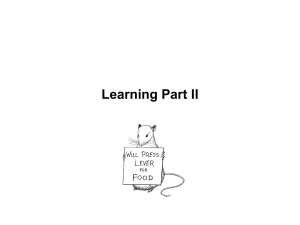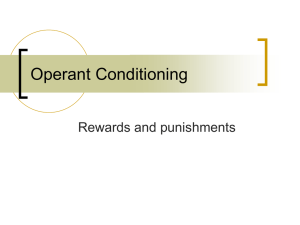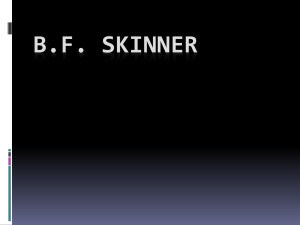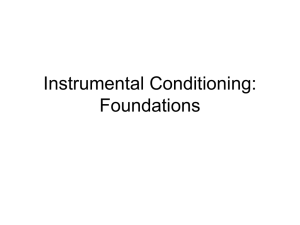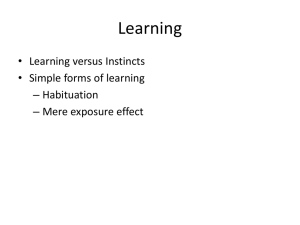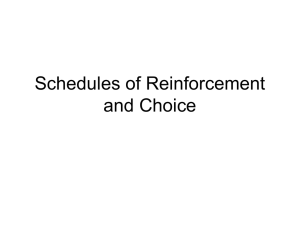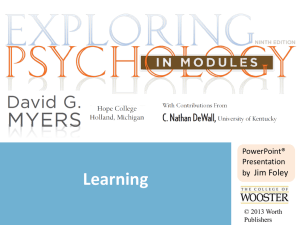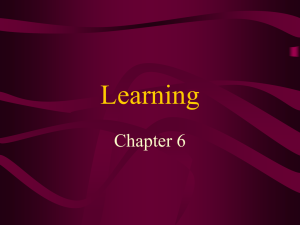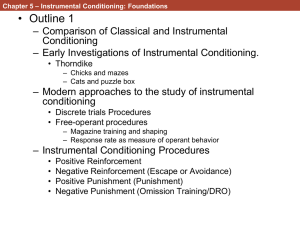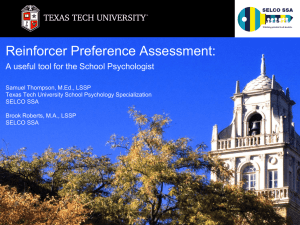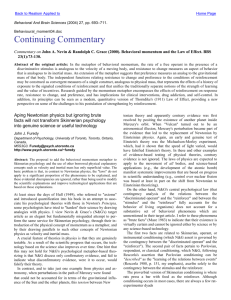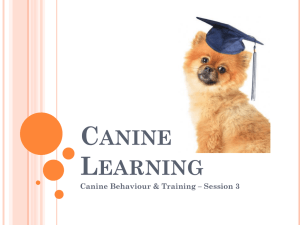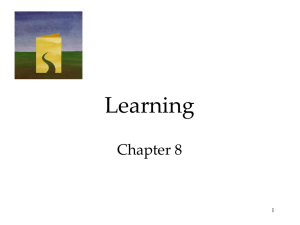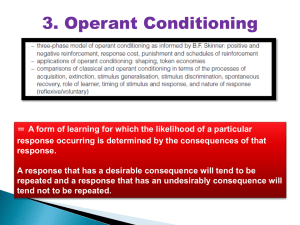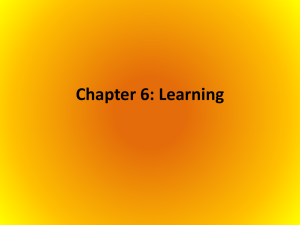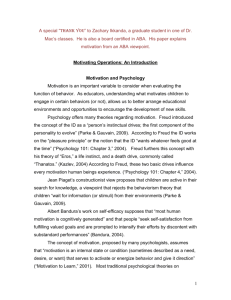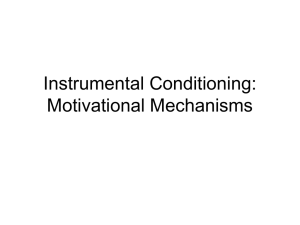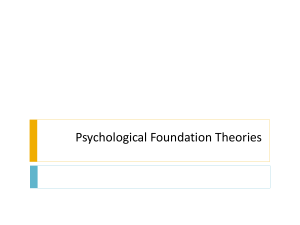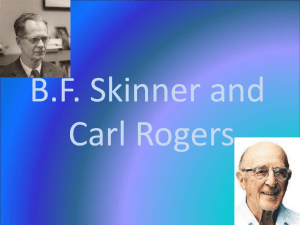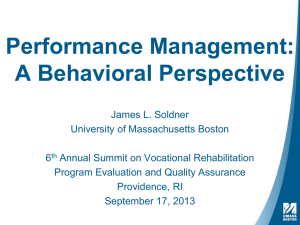Operant Conditioning
advertisement
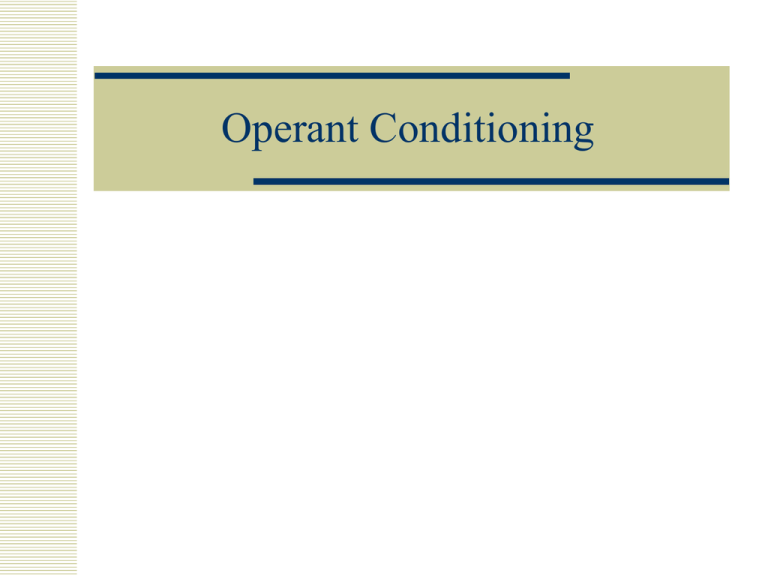
Operant Conditioning Complex Learning Why do we learn new behaviors? Classical conditioning only deals with reflex responses that we already possess. Most of our behaviors are voluntary. Volitional. Stimulated by something in our environment. Operant Conditioning Defined as - the form of learning concerned with changes in emitted responses as a function of their consequences. Origins of Operant Conditioning Edward Thorndike Instrumental Conditioning “Law of Effect” Satisfying outcome Unsatisfactory outcome Outcomes of Thorndike’s Work How Long - the length it declined ofAs time it tooklearning the cat to was taking escape fromplace. the puzzle This change in box. performance represented a change in behavior from experience. Learning Question In Thorndike’s terms, what sort of things give you satisfaction? What things produce dissatisfaction? Why? Edward Thorndike His research provided a foundation for the study of “non-reflexive” learning. He drew a connection between action and its outcomes. B. F. Skinner Skinner coined the term “operant”. Disagreed with the “soft” concepts of Thorndike’s “satisfying” and “unsatisfactory” outcome(s) B. F. Skinner Operant Conditioning replaced Thorndike’s term “instrumental learning” Emitted behavior is now called “operant responses” Classical conditioning is now called ‘respondent conditioning. The Skinner Box or “autoenvironmental chamber” Skinner Box in Action Zack Florin '99 using a Skinner box to shape a rat's behavior Reinforcment Primary reinforcers - food, water, shelter. Those innate biological needs. Secondary reinforcers (Conditioned reinforcers) - something that will provide a primary reinforcer. (money, poker chips etc.) Primary vs. Secondary Which of the following are secondary reinforcers: quarters spilling from a slot machine, a winner’s blue ribbon, a piece of candy, an A on an exam, frequent-flyer miles. Reinforcement Negative Reinforcer - an aversive stimulus which serves to decrease the probability of the response in the future. Positive Reinforcer - a stimulus which when applied increases the probability of the response in the future. Contingencies of Reinforcement According to Skinner the relationship between a response and a reinforcer is a contingency. One type of contingency is “reinforcement” Desired change in behavior Type of reinforcer Increases response Decrease response Positive reinforcer POSITIVE REINFORCEMENT OMISSION NEGATIVE REINFORCEMENT PUNISHMENT Negative reinforcer (escape, avoidance) (withholding positive reinforcer) Shaping Some learning does not occur in a single event. A series of successive steps leads to a learned behavior. Playing the piano, swimming etc. Applying the Principles When asked choose the best alternative and explain why. You want your 2-year-old to ask for water with a word instead of a grunt. Should you give him water when he says “wa-wa” or wait until his pronunciation improves. Applying the Principles When asked choose the best alternative and explain why. Your roommate keeps interrupting your studying even though you have asked her/him to stop. Should you ignore her/him completely or occasionally respond for the sake of good manners?. Applying the Principles When asked choose the best alternative and explain why. Your father, who rarely writes to you, has finally sent a letter. Should you reply quickly or wait a while so he will know how it feels to be ignored?. Extinction What happens when the reinforcement stops. Extinction - in operant conditioning, a drop I responding when reinforcement is discontinued. Schedules of Reinforcement Continuous reinforcement - every response is followed by a reinforcer. (FR1 schedule) Partial reinforcement - a contingency of reinforcement in which every response does not get a reinforcer. Fixed Interval Schedule Referred to as FI x reinforcement contingency defined by the amount of time that must pass since the previous reinforcer. Based on time. Example: pay checks Fixed Ratio Schedule Referred to as FR x reinforcement contingency defined by the number of responses the organism must make in order to get a reinforcer. Example: piece work. Variable Interval Schedule Referred to as VI x - a reinforcement contingency defined by the average time interval which must elapse since the last reinforcer. Example: Quality Control Variable Ratio Schedule Referred to as VR x - a reinforcement contingency defined in terms of the average number of responses required to receive a reinforcer. Example: Slot Machine Non-Contingent Reinforcement Random “reinforcement” Development of what Skinner called ‘superstition’ in the pigeon. Applying Conditioning We must always keep in mind that all this is done to match the goals of psychology. Behavior Modification. Mary Cover Jones - the mother of behavior therapy Aversive Positive Controls Punishment Most used and most misunderstood Occurs after the ‘offense’ has taken place. Requires “contiguity” Encourages avoidance behaviors. Negative Reinforcement Autonomic Conditioning Neal Miller and Leo DiCara ‘proprioceptive feedback Biological Constraints Some unanswered questions: Equipotentiality premise Ethology Species-specific behavior Critical period Preparedness • The The premise that principles Behaviors which are A study period of during the behavior of A concept developed by ofdevelopment conditioning willmembers apply characteristic of all animals in their natural where there Martin Seligman to toare any response and any of a particular species. environment. optimal periods for describe how species. (instincts) learning. physiological structure influences the occurrence of behavior Biological Constraints Degree of biological preparedness Prepared Species-specific behavior Unprepared Bait Shyness Classical and operant conditioning Contraprepared Unlearnable Associations
